 DRACULA (1931)
DRACULA (1931)Directed By: Tod Browning
Written By: Bram Stoker, Hamilton Dean, John L. Balderston, Garrett Fort, Dudley Murphy, Louis Bromfield, Tod Browning, Max Cohen, Louis Stevens
Cast:
Bela Lugosi as Count Dracula
Helen Chandler as Mina Harker
David Manners as John Harker
Dwight Frye as Renfield
Edward Van Sloan as Prof. Abraham Van Helsing
Herbert Bunston as Dr. Jack Seward
Frances Dade as Lucy Weston
Joan Standing as Briggs
Charles K. Gerrard as Martin
Geraldine Dvorak as Dracula's Wife
Dorothy Tree as Dracula's Wife
Cornelia Thaw as Dracula's Wife
Runtime: 75 Minutes
Country: USA
Language: English
Color: Black and White
Sound Mix: Mono
Released: February 14, 1931
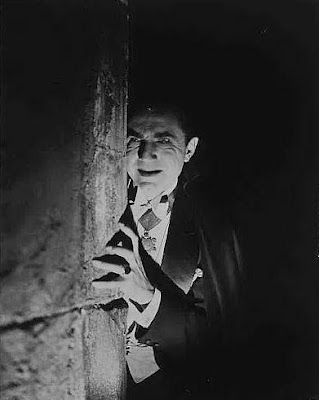 Written By: Ken Hulsey
Written By: Ken HulseyThe former London Lyccum Theatre manager, Bram Stoker is often credited with creating modern vampire lore through his Victorian novel Dracula, which was published on May 18, 1897. Though the inspiration for dozens of films, TV series, books and plays, Dracula was not a successful novel and is not considered an important work in Victorian literature. It is modern folklore that the inspiration for the vampire in his book was the infamous Vlad III Dracula (“Vlad the Impaler”) yet most scholars agree that is not the case. Though Stoker did discover the name “Dracul” (Dragon) while studying Romanian history and used it for the name of his vampire character, that is where the connection ends. It is a fact that the author was inspired by earlier vampire stories such as Emily Garads “Transylvania Superstitions (1885), Sheridan Le Fanu’s “Carmilla” (1871), John Polidori’s “The Vampyre” (1819) and Lord Byron’s “The Giaour” (1813). The main inspiration, however, would come from the Hungarian Countess Elizabeth Bathory who reportedly killed 700 servant girls to bathe in or drink their blood in attempt to achieve everlasting life. Yet another inspiration was the former Lyceum Theatre manager Henry Irving. Dracula’s mannerisms and gestures were directly copied from Irving, who Stoker often tried to convince to play the vampire in a stage performance of his novel. Regardless of the true origins of Stoker’s Dracula the character has now become the stereotype for which all vampire adaptations that followed have been based.
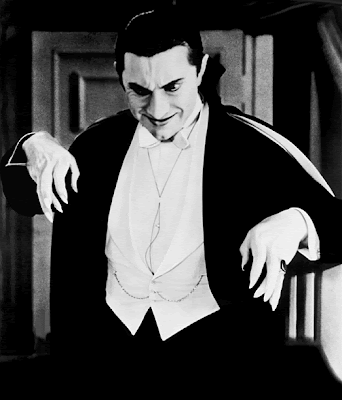
In 1922 the first film based on the Bram Stoker novel was produced. While originally the movie was to be titled “Dracula” the films producers failed to get permission from Stoker’s widow and the title was changed to “Nosferatu: eine Symphonie des Grauens” (“Nosferatu: A Symphony of Horror). Copyright problems also mandated the location of the story to be moved from England to Transylvania and Germany. The name of the vampire also had to be changed from Dracula to Count Orlock. Method actor Max Schreck would become infamous for his portrayal of Orlock, which to this day is probably the most frightening of any movie vampire in the history of film. It has often been noted that Schreck was such a devoted method actor that he actually began to believe he was a vampire and only could be called for shooting after the sun had gone down. Stoker’s estate was able to win several lawsuits against the makers of “Nosferatu” and all copies of the film were to have been destroyed. All the prints of the film that survive today come from pirated copies that escaped destruction.
More After The Break
 Product Description
Product DescriptionFeature titles include: Dracula (1931), Dracula (1931) - Spanish Version, Dracula's Daughter, House of Dracula, Son of Dracula Special Features
Contains four films on two discs
The original documentary The Road to Dracula
Feature film commentary by film historian David J. Skal
New Phillip Glass score on Dracula
Dracula on DVD From Amazon.com:
Dracula - The Legacy Collection (Dracula / Dracula (1931 Spanish Version) / Dracula's Daughter / Son of Dracula / House of Dracula)
Dracula (75th Anniversary Edition) (Universal Legacy Series)
Dracula (Universal Studios Classic Monster Collection)
On VHS From Amazon.com
Dracula [VHS]
Video On Demand From Amazon.com
Dracula (1931)
In 1927 a theatrical adaptation of “Dracula” written by Hamilton Deane and John L., Balderston became a huge hit on Broadway. This play would star the Hungarian born actor Bela Lugosi who didn’t speak a word of English. Lugosi learned all his lines phonetically, which produced the famous speech pattern that Dracula (and most vampires) would become associated with.
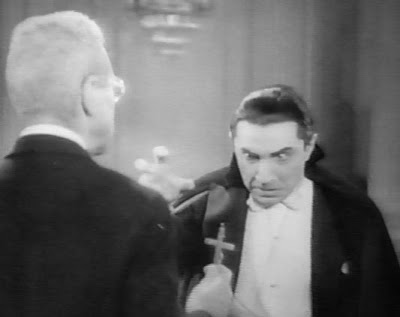 Bela Lugosi (Bela Ferenc Dezso Blasco) came to America in the 1920s’ to pursue an acting career. Even though the actor had starred in several small roles prior, he would always be remembered for portraying Dracula, both on stage and in numerous films. After Dracula became a huge hit the actor was offered the part of “The Monster” in “Frankenstein”, which he turned down. Boris Karloff would become famous for the part, and Lugosi’s short term as the “King of Horror” would end as quickly as it started. Lugosi would go on to play Dracula and other various vampires throughout his career. The actor managed to beat a drug addiction, but ended his career in low budget features such as the infamous “Plan 9 From Outer Space” which would be his last film. He passed away while it was still in production. Despite all of his stage and film roles the actor died in poverty.
Bela Lugosi (Bela Ferenc Dezso Blasco) came to America in the 1920s’ to pursue an acting career. Even though the actor had starred in several small roles prior, he would always be remembered for portraying Dracula, both on stage and in numerous films. After Dracula became a huge hit the actor was offered the part of “The Monster” in “Frankenstein”, which he turned down. Boris Karloff would become famous for the part, and Lugosi’s short term as the “King of Horror” would end as quickly as it started. Lugosi would go on to play Dracula and other various vampires throughout his career. The actor managed to beat a drug addiction, but ended his career in low budget features such as the infamous “Plan 9 From Outer Space” which would be his last film. He passed away while it was still in production. Despite all of his stage and film roles the actor died in poverty.Carl Laemmle Jr. had a vision for a big screen adaptation of “Dracula” for Universal that would have been in the same league as “The Hunchback of Notre Dame” and “The Phantom of the Opera.” Laemmle was also very insistent that Lon Chaney, play the vampire in his picture and set out to lure him away from Metro-Goldwyn-Mayer. Unfortunately Lon Cheney passed away from throat cancer before production was set to begin.
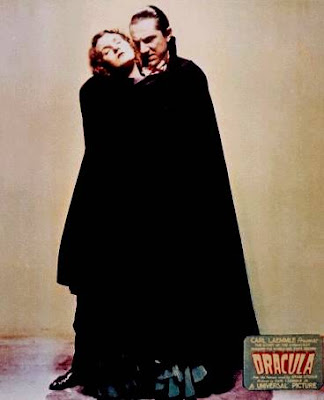 Balderson Broadway play for the basis of his production.
Balderson Broadway play for the basis of his production.Carl Laemmle would end up hiring Tod Browning to direct the film and together they would begin a search for an actor to play the vampire. Ian Keith was the top choice to play “Dracula”, but Lugosi did everything he could to change their minds. Despite rave reviews for his portrayal on Broadway, Lugosi was not what the duo had in mind. Ultimately Bela Lugosi would end up as Dracula, but only after he agreed to a salary far below that of his co-stars.
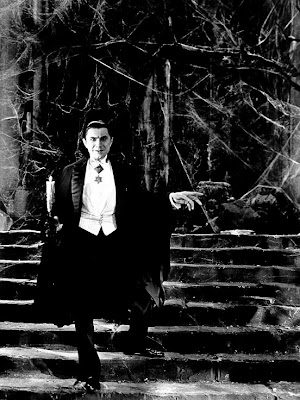 While the standard version of “Dracula” was being shot during the day there was a Spanish version under the direction of George Melford being shot at night. This film used the exact script and sets as the English language version. The “night crew” had the advantage of being able to view takes from the days shoot and work out better camera angles and lighting. Since the film was produced for distribution outside the US it didn’t have to worry about censorship under the Hayes Code, so scenes that were not allowed in the standard version made it into the Spanish print. Another advantage that the production had was the ability to use some of Browning’s alternate takes for stock footage. It is for these reasons most fans feel that this version is actually superior to Legosi’s classic. The film, along with all the alternate language versions of classic monster films produced by Universal, was believed to be lost forever. In the late 1970s’, however, a complete print of the film was discovered and it was fully restored in 1990.
While the standard version of “Dracula” was being shot during the day there was a Spanish version under the direction of George Melford being shot at night. This film used the exact script and sets as the English language version. The “night crew” had the advantage of being able to view takes from the days shoot and work out better camera angles and lighting. Since the film was produced for distribution outside the US it didn’t have to worry about censorship under the Hayes Code, so scenes that were not allowed in the standard version made it into the Spanish print. Another advantage that the production had was the ability to use some of Browning’s alternate takes for stock footage. It is for these reasons most fans feel that this version is actually superior to Legosi’s classic. The film, along with all the alternate language versions of classic monster films produced by Universal, was believed to be lost forever. In the late 1970s’, however, a complete print of the film was discovered and it was fully restored in 1990.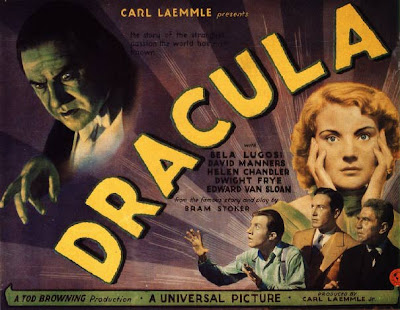
Dracula would premiere on Valentine’s Day 1931, and was billed as “The strangest love story of all.” The film gained nationwide media attention when it was reported that audience members often times fainted from the horror portrayed on the screen. This was a very well executed publicity stunt orchestrated by Universal who placed actors in the audience at select screenings who would indeed faint or scream at predetermined times. The stunt paid off and people packed theatres to see the film, if for nothing else than for the sake of curiosity. The popularity of both Dracula and Frankenstein, which was released later the same year, would help pave the way for a series of horror films that would secure Universal as the king of the horror genre for decades to come.
Trailer:
The greatest vampire film of all time and the ultimate performance of Dracula.
ReplyDelete